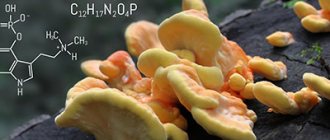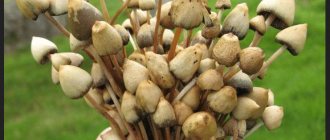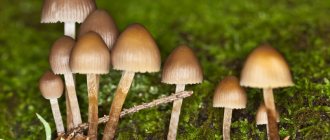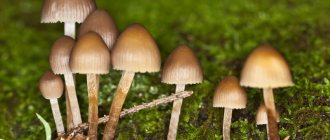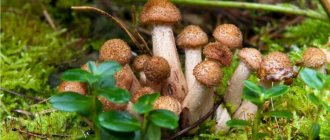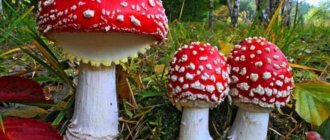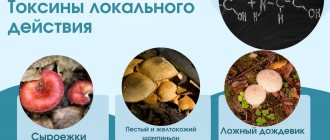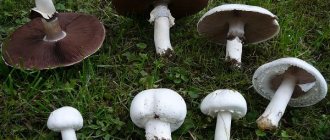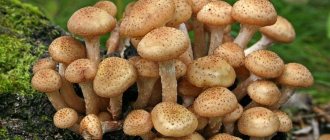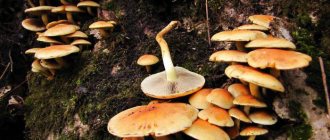Numerous figurines in the form of mushrooms with human and demonic guises, created by the Mayan and Aztec tribes, are eloquent evidence of religious and mystical rituals using mushroom psychoactive substances. Similar evidence that mankind’s acquaintance with natural hallucinogens occurred long before our era is provided by African rock paintings left 9,000 years ago.
Historical Roots of Psilocybin
Humanity discovered hallucinogenic psilocybin mushrooms in ancient times, as evidenced by archaeological finds. The Aztecs and Mayans, African and northern shamans knew well what psilocybin is. They used mushrooms in rituals to put them into a narcotic trance. When Latin America was conquered by Europeans, shamanic practices were banned by the Inquisition.
All researchers recognize that mushrooms are highly toxic and dangerous to humans. The narcotic substance is concentrated mainly in the legs, from where in the 50s of the twentieth century it was isolated by scientist A. Hoffman, who first synthesized psilocin. At this time there was a surge of interest in mushrooms and the hallucinogenic effect they provided.
From the history
An interesting fact, but psilocybin has found its use in medicine, as an adjuvant in the treatment of a number of neuroses. It has the ability to awaken or activate a person’s “affective memory.” Psilocybin is capable of recalling certain memories so clearly and clearly that this forgotten past can be perceived by the patient no less vividly than the present. This can help a psychologist not only reconstruct the events that led to neurosis, but analyze them as constructively as possible.
Due to its pronounced narcotic properties, psilocybin has become very popular among drug addicts. In terms of its effect on the human body, it is similar to LSD, but has a greater “naturalness” of the resulting sensations. The duration of this effect can last from 4 to 7 hours, depending on the dosage taken.
The first mentions of hallucinogenic mushrooms can be found in documents devoted to the history of the colonization of America. As an independent chemical substance, psilocybin was discovered by scientist Albert Hofmann in 1958. Within a couple of years, Richard Alpert and Timothy Leary became interested in it, and they began conducting experiments with it together with graduate students from Harvard. Albert Hofmann also continued his study of psilocybin and in April 1962, 20 people (students) took part in the famous “Boston” experiment, also called the “psilocybin experiment.”
Since 1968, psilocybin has been banned and considered an illegal drug, a historic drug law has been issued (“US Drug Abuse Regulation and Control Act of 1970. Schedule I, II, III), placing most psychedelic and hallucinogenic drugs on the list of prohibited substances. Psilocybin is prohibited along with such drugs as LSD, psilocin, hashish, MDA, mescaline, coca bush, peyote, cocaine, amphetamine and metamorphine. Until 1977, psilocybin continued to be studied as a medicine for psychotherapeutic needs. Since 2002, mushrooms have become illegal in Japan, they are prohibited for sale, but some well-known stores in Japan were allowed to sell mushrooms in stock. In Russia, psilocin and psilocybin are also included in the lists of prohibited narcotic drugs, and storage more than 50 mg carries criminal liability.
How psilocybin affects the body: method of administration and symptoms
The substance is taken orally - directly in the form of dried mushrooms. When it enters the intestines, the alkaloid disintegrates, psilocin is released from it, it penetrates the blood, stimulating the hormone serotonin. A person under its influence experiences pleasant emotions, joy, his reality is distorted, hallucinations appear in the form of visual images and sounds - for example, people see themselves from the outside, observe fractal patterns.
Brain neurons, where the toxin enters through the blood, are affected in several areas:
- the medial prefrontal zone, which in a healthy person is almost always active, but under the influence of a drug slows down its activity;
- the cingulate gyrus in its posterior part - the centers responsible for processing incoming information and forming a picture of the world, which psilocybin distorts, are concentrated there;
- the anterior part of the cingulate gyrus, which is excited in a state of depression - the substance slows it down, so under its influence drug addicts have a good mood, they stop worrying and feel emotional lightness.
Psilocybin - history of the appearance of the substance, chemical formula
Psilocybin is a distinct psychedelic substance that is derived from psilocin, an alkaloid in the tryptamine family. The compound has a low level of toxicity, but despite this, it has a strong psychological effect.
The chemical formula of this drug is quite complex; in general it is C12H17N2O4P. It is mainly found in mushrooms of the genus Psilocybe, which are common on all continents. They live in soil, dead plants, sawdust, swamps, and manure. They are also sometimes found in forested areas.
The traditions of using these mushrooms go back centuries. They were actively used by Indian tribes, as evidenced by images of mushrooms decorated with the faces of gods and demons. Translated from the Aztec language, the name of these mushrooms means the flesh of god.
Among Europeans, the first information about this substance spread in the sixteenth century. This was due to the fact that it was during this period that the discovery of Mexico and its conquest fell. However, knowledge about the drug is spread rather poorly due to the strong protection of it by indigenous tribes. The pure substance was first synthesized in 1958 by the famous scientist Hofmann.
Signs, symptoms and consequences of use
The symptoms and effect of using the substance are very subjective, since it affects the psyche and is weakened if taken after a meal. The duration of action also depends on the characteristics of a particular organism. Typically it lasts 4-8 hours, during which a person falsely perceives the surrounding reality and falls into a delusional state. His vision and hearing become more acute, anxiety and paranoia may begin, and anxiety may increase.
The nature of hallucinations cannot be predicted; it depends on personality characteristics, mood, and external conditions. The alkaloid changes the healthy exchange of signals within the brain, affects the central nervous system, which causes external signs of its use:
- short-term memory disorders, absent-mindedness;
- increased temperature, increased heart rate, dilated pupils;
- tremor of the limbs; impaired coordination and coherence of speech;
- anxiety and sudden mood swings;
- exacerbation of phobias, panic attacks.
The substance causes destruction of the myelin sheaths of the brain and degeneration of the hippocampus. A number of fungi additionally provoke pulmonary failure, kidney and heart diseases, convulsions and even coma.
Classic psychoactive substances
Psilocybin
Psilocybin is the active ingredient in a large family of psychedelic mushrooms called pica nu hat (Liberty Cap in English, Psilocybe Semilanceata in Latin). They grow in temperate climate zones. Within the mushroom family, there are 30 species that contain psilocybin. Its amount in individual species depends on growth conditions. Mushrooms can be eaten, but they are not of interest in terms of taste. Psilocybin takes about 30-45 minutes to take effect. The tide lasts 4-6 hours.
Psilocybin has been used in Central and South America for ritual ceremonies for over 3,000 years. The drug was first chemically isolated and prepared in the laboratory in 1958-59 by chemist Albert Hoffman.
Psychedelic LSD
LSD (acid) is short for lysergic acid diethylamide. LSD is a powerful psychoactive drug that is usually taken in micrograms, whereas other drugs are taken in milligrams. The substance is available in the form of capsules or tablets. However, LSD can also be taken as a liquid sprayed onto paper.
The drug was discovered by Albert Hoffman in 1938. The effect of LSD is relatively long lasting and can last up to 10-12 hours.
Psychoactive substance ayahuasca
Ayahuasca is a psychedelic drink (a kind of tea). Ayahuasca has been used in the ritual context of the tribal peoples of the South American jungle for hundreds of years. Most often, such rituals are performed by shamans, who act as a kind of spiritual guide while taking drugs. In recent years, more and more centers have opened in the Western world, where these substances are also taken in controlled ceremonies.
The drink contains a plant extract containing the psychedelic substance DMT (dimethyltryptamine) and a monoamine oxidase inhibitor from other plants. The latter is a necessary ingredient for DMT to be absorbed in the intestines and reach the brain. Consuming ayahuasca often results in nausea and vomiting.
Psychedelic mescaline
The substance is synthesized from the dried roots of the Peyote cactus. The psychedelic dose is usually 0.3 -0.5 g and lasts 12 hours. The drug has been used by North American Indian tribes for hundreds of years. The experience of working with matter is perfectly described by the author Aldous Huxley in his book The Doors of Perception.
Psilocybin addiction
Psilocybin addiction - what is it and should we take it seriously? Without a doubt, it's worth it. The substance does not provoke physical dependence, but the psychological one is extremely high. It arises gradually and becomes the cause of severe depression, suicidal thoughts, and actions that are dangerous to oneself and others. Regular use of psilocybin leads to deterioration of intellectual abilities and acute psychosis. Quitting a drug does not guarantee a return to normal functioning, so addiction must be stopped as early as possible.
How do psychedelic drugs work?
The psychedelic effect of this group of substances occurs through the serotonin receptor in the brain. The stronger the psychoactive substance, the better the drug stimulates that particular receptor. In addition, most of the psychedelic effect is eliminated by experimentally blocking the serotonin 2A receptor.
The effects of psychedelic drugs depend on the individual characteristics of the user’s body and the environment in which he is located. Many people prefer a quiet environment when using these drugs. All sensory impressions are enhanced, but also distorted. The user may feel unsafe as sensory impressions seem more clear. Objects in the environment can change shape, size, color. Users of psychedelic drugs often describe them as interesting, more organic and alive.
How to get rid of addiction
Traditional drug replacement therapy is not effective for psilocybin addicts. In contrast, the Narconon social adaptation program includes techniques that eliminate psychological dependence and help restore normal skills - social and cognitive. Drug addicts go through the following stages:
- physical restoration in the form of a balanced diet, normalization of sleep, special massages;
- restoring social skills, gaining a clear outlook on life, helping to avoid returning to the past;
- developing skills for constructive problem solving and awareness of responsibility for actions, obtaining tools for completely quitting drugs in the future.
For most patients, completing the program takes several months. After which they return to a healthy life.
Share:
What is nasvay?
What is opium?
Feelings after use
- Memories become clearer and more vivid than usual and seem to emerge from the subconscious.
- The sense of time and space are lost.
- Consumers describe that the distinction between themselves and the surrounding environment and people disappears. This causes a state where a person feels “one with everything.” This could ultimately lead to so-called Egodis integration. That is, the feeling that a person no longer exists as a person until the effect diminishes.
- The sensory experiences can even be frightening. You may notice bodily phenomena that previously did not attract attention.
- The tide usually comes and goes in waves.
Chronic effects
The most severe consequences of long-term use of hallucinogens are persistent mental disorders that require long-term, sometimes lifelong, observation and treatment by a psychiatrist. In milder cases, people who have used LSD for many years experience so-called “thrust flashbacks.”
Against the background of sobriety, perception disturbances, difficulties in thinking, and hallucinatory images similar to those experienced when using the drug may appear. The most common, long-lasting effect is depression.
Treatment
Drug treatment is required in case of overdose. Acute agitation is relieved and panic is relieved with the help of sedatives. Drug assistance is also needed for persistent mental disorders, or “intruding memories” expressed in emotional coloring, which can lead to episodes of anxiety, agitation, fear or depression. Basic treatment involves long-term psychological support to overcome addiction.
The full price list can be found at the medical center or by calling the hotline: +38(099) 508-08-88
*The administration of the Ukrainian Addiction Treatment Center takes all measures to timely update the price list posted on the website, however, in order to avoid possible misunderstandings, we advise you to clarify the cost of services in the contact center by phone: +38 (099) 508-08-88. The posted price is not an offer. Medical services are provided on the basis of a contract. There are contraindications. Specialist consultation is required.
Author: Sergey Adamenko
Medical information is correct, reliable, and up-to-date. Program Director of the Association of Rehabilitation Centers
Pathophysiology
Psilocybin and LSD have been found to bind to serotonin-sensitive receptors, blocking them, sometimes irreversibly. This leads to an initial feeling of boundless bliss and joy, euphoria and vivid emotions.
Subsequently, the concentration of the substance in the blood decreases, and the action of natural, own serotonin is impossible - the receptors are blocked. The consumer develops a pronounced anxiety-depressive state, which explains the formation of a strong psychological dependence.
Description
Psilocybe semilanceolata is similar to almost all other hallucinogenic mushrooms that grow on dung substrates, but is more psychoactive due to the high content of psilocin and psilocybin.
hat
Psilocybe semilanceolate.
This is a small mushroom with a cap up to 2.5 cm. The shape is distinctly conical with a papilla in the middle. The edges are often turned downwards. The surface is slimy; in young specimens the skin comes off easily.
The color of the cap depends on the humidity of the weather: with frequent rains, mushrooms with a darker cap grow. Color: from light to dark brown.
The plates are often translucent, causing the surface to appear longitudinally striped (this effect is more often observed in mushrooms grown in very humid conditions).
Leg
The stalk of Psilocybe semilanceolate is long, thin and elastic. In young specimens the leg is covered with small scales, in older specimens it is smooth. The leg has a lighter color than the cap. The dimensions of the leg are 10 * 0.3 cm in length and in diameter, respectively, and contains a cavity inside.
Spore-bearing layer
Sharp conical bald spot.
Hymenophore psilocybe semilanceolate lamellar. The plates are relatively thick and sparsely spaced. When young, the plates have a light brown color, which darkens almost to black with age, and the blackness extends to the edges of the cap.
Pulp
There is quite a bit of pulp in Psilocybe semilanceolate. Its color is almost white (yellowish). Smells faintly of hay and a little mildew. There is practically no taste.
Spore powder
The spores of Psilocybe semilanceolate are large, ovoid, and have a pore. The mass of the powder is very dark purple or brownish, almost black.
